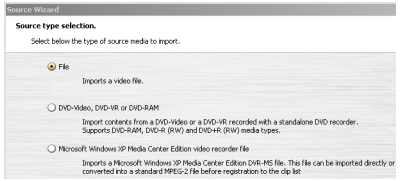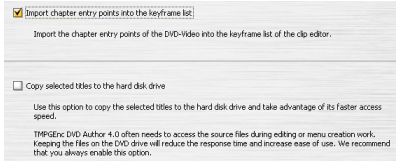MPEG-2 Formats
Depending on what your purpose in encoding an MPEG file is, the range of options supported for playback may be more limited than the MPEG-2 specifications allow. When you select an output format like DVD or SVCD there will be certain settings that can't be changed. You can get around these limitations by selecting the generic MPEG file output option, but be aware that this will allow you to create an MPEG file that may not be playable in a standalone player if you don't know what you're doing. If you do, however, TMPGEnc XPress gives you access to many settings
In the course of this guide each settings tab from the Generic MPEG File Output format will be described. Pre-defined templates for formats like DVD or VCD will be described later. The meaning of some MPEG encoder settings won't be described in great detail as they're already discussed in our MPEG-2 encoding guide.
Source Files

To add a source file for encoding, click either the Add file or Source Wizard button. While Add file opens up a standard Windows Open dialog to select a supported video source, The Source Wizard gives you additional options to open either one of a variety of DVD formats or a DVR-MS file from Windows Media Center Edition. DVD video often needs to be reconstructed by joining VOBs as one continuous file, and DVR-MS files need to be removed from their Microsoft container to be treated as standard MPEG files. The File button in the Source Wizard dialog works like the Add File button in the main TMPGEnc XPress window.
Some video files use containers that TMPGEnc doesn't recognize, such as MP4. If you have the proper software installed, which may include a media splitter and DirectShow decoder, you can change Files of type at the bottom of the open dialog to read All files. That should allow you to select your source files. If you're opening a more common format like AVI or MPG this shouldn't be a problem.
DVD Source Files
 If you want to use titles in VOB files from a DVD as a source you can use the DVD-Video, DVD-VR, or DVD-RAM option in the Source Wizard. After you browse to the folder containing the DVD file system, TMPGEnc XPress will read the DVD's title table to provide you with a list of titles to choose from. To select a title, check the box next to it and make sure to select the desired audio and subpicture streams from the dropdown lists.
If you want to use titles in VOB files from a DVD as a source you can use the DVD-Video, DVD-VR, or DVD-RAM option in the Source Wizard. After you browse to the folder containing the DVD file system, TMPGEnc XPress will read the DVD's title table to provide you with a list of titles to choose from. To select a title, check the box next to it and make sure to select the desired audio and subpicture streams from the dropdown lists.

The next step will offer you the option to copy chapter points to a keyframe list to make sure the output stream will have I frames in the correct places to allow identical chapter placement. Another option on the final Source Wizard dialog should be checked if you want to copy the DVD files to your hard drive before using them as a source. This will be faster than reading from a DVD drive, and generally better for the drive.
Format Selection

When you select the Format button at the top of the main window, you'll get a list of available templates. Basic templates are included with the program, and should automatically show up here. You can save encoder settings as custom templates. You can also select a template like DVD Standard Template, and have TMPGEnc XPress copy the settings to the generic MPEG template, allowing you to use calculation tools from a format specific template, but still get full access to tweak MPEG encoding options. Clicking the MPEG output button on the right side of the window will create a new output entry and copy settings from the specialized template.

Output stream type
TMPGEnc XPress can create elementary streams to give you separate audio and video output or system streams to give you program files. If you're encoding for authoring to DVD or a similar format, it's usually best to work with elementary streams and let the authoring software handle muxing. You can select the stream type after you've selected an output format. The selection is made on the right side of the Format window.

